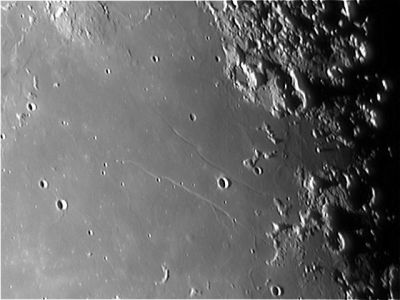Cauchy
Contents
Cauchy
|
Lat: 9.6°N, Long: 38.6°E, Diam: 12 km, Depth: 2.67 km, [/R%C3%BCkl%2036 Rükl: 36] |
Table of Contents

Derek Francis Cauchy is the small circular crater at about 4 o'clock from the center of this Earth-based image. The faint diagonal lines nearby are [/Rima%20Cauchy Rima Cauchy] (above) and [/Rupes%20Cauchy Rupes Cauchy] (below).
Images
LPOD Photo Gallery Lunar Orbiter Images Apollo Images
- ASU Apollo Image of the Week
- AS08-13-2344 is perhaps the most well-known and most frequently reproduced orbital Hasselblad of Cauchy and the nearby [/Rima%20Cauchy Rima Cauchy] and [/Rupes%20Cauchy Rupes Cauchy]. This extraordinary photograph was included on pages 616-617 of the article A Most Fantastic Voyage by Lt. Gen. Sam C. Phillips (The Story of Apollo 8's Rendez-Vous with the Moon; National Geographic, May 1969). Research: Danny Caes.
Maps
([/LAC%20zone LAC zone] 61A3) LAC map Geologic map LTO map USGS Digital Atlas (nomenclature PDF)
Description
Description: Elger
([/IAU%20Directions IAU Directions]) CAUCHY.--A bright little crater, not more than 7 or 8 miles in diameter, on the E. side of the [/Mare%20Tranquillitatis Mare Tranquillitatis], N.W. of [/Taruntius Taruntius]. It has a peak on its E. rim considerably loftier than the rest of the wall, which is visible as a brilliant spot at sunrise long before the rest of the rampart is illuminated. On the S. there are two bright [/Rupes%20Cauchy longitudinal ridges] ranging from N.W. to S.E. These stand in the position where Neison draws two straight clefts. The [/Rima%20Cauchy Cauchy cleft], however, lies N. of these, and terminates, as shown by Schmidt, among the mountains N.W. of [/Taruntius Taruntius]. I have seen it thus on many occasions, and it is so represented in a drawing by M.W. Stuvaert (Dessins de la Lune). There is a number of minute craters and mounds standing on the S. side of this cleft, and many others in the vicinity.
Description: Wikipedia
Additional Information
- Depth data from [/Kurt%20Fisher%20crater%20depths Kurt Fisher database]
- Pike, 1976: 2.67 km
- Arthur, 1974: 2.61 km
- Westfall, 2000: 2.67 km
- Viscardy, 1985: 2.6 km
- Cherrington, 1969: 1.79 km
- Cauchy & Cauchy D are thermal anomaly craters, implying youthful ages - [/Moore%20et%20al%2C%201980 Moore et al, 1980]
- Cauchy shows a curious clair-obscur effect at the shadow of its western rim, a couple of hours after local sunrise. The shadow looks "interrupted" at its central part. This "interruption" is caused by a curious wing-like formation at the crater's western rim. Two wing-like appendages run north-northwest and south-southwest (radiating out of the crater's western rim). A similar formation is noticeable at crater [/Kies Kies] A in the southwestern part of [/Mare%20Nubium Mare Nubium]. Observations and research: Danny Caes.
- Paolo Lazzarotti's LPOD photo of Cauchy and surroundings shows the curious "interrupted" appearance of Cauchy's shadow very well!- DannyCaes DannyCaes Jan 20, 2009
- TSI = 10, CPI = 5, FI = 5; MI =20 [/Smith%20and%20Sanchez%2C%201973 Smith and Sanchez, 1973]
Nomenclature
- Named for Augustin Louis Cauchy (August 21, 1789 – May 23, 1857), a French mathematician. He started the project of formulating and proving the theorems of calculus in a rigorous manner and was thus an early pioneer of analysis.
- According to [/Whitaker Whitaker] (p. 223), this name was introduced by [/Neison Neison].
- On LTO-61B4 (prepared in November 1973) the [/DMA DMA] erroneously introduced the name [/N%C3%B6ther Noether] for the [/satellite%20feature satellite feature] Cauchy D. The name [/N%C3%B6ther Noether] (spelled there "Nöther (or Nöter)") had actually been previously approved by the [/IAU IAU] for an unrelated farside crater, and had been published in [/Menzel%2C%201971 Menzel, 1971]. Hence the use of [/N%C3%B6ther Noether] as a replacement for Cauchy D appears in Ewen Whitaker's list of [/Invalid%20Names Invalid Names].
- Cauchy A is called Hussein on LTO-61A2. This is another [/Invalid%20Names invalid name]. Who was Hussein? See this Wikipedia-page.
- Hussein (Cauchy A) is one of the few LTO-related "new" crater-names which are located at the moon's Near Side. Most of those names are located at the moon's eastern limb (near Mare Smythii), and at the moon's Far Side. - DannyCaes DannyCaes Mar 29, 2008
- Cauchy D hills (a nickname from D.Caes for the cluster of hills north-northeast of the bowl-shaped crater Cauchy D, at the western part of Sinus Concordiae) (these hills seem to be sections of an ancient crater, see SLC-A4) (System of Lunar Craters).
LPOD Articles
Is it love or a sinus infection?
Cauchy times two
Lunar 100
[/Lunar%20100 L48]: "Fault, rilles, & domes."
Bibliography
Wöhler, C. and others (2006) A combined spectrophotometric and morphometric study of the lunar mare dome fields near Cauchy, Arago, Hortensius and Milichius. Icarus.
This page has been edited 1 times. The last modification was made by - tychocrater tychocrater on Jun 13, 2009 3:24 pm - afx3u2